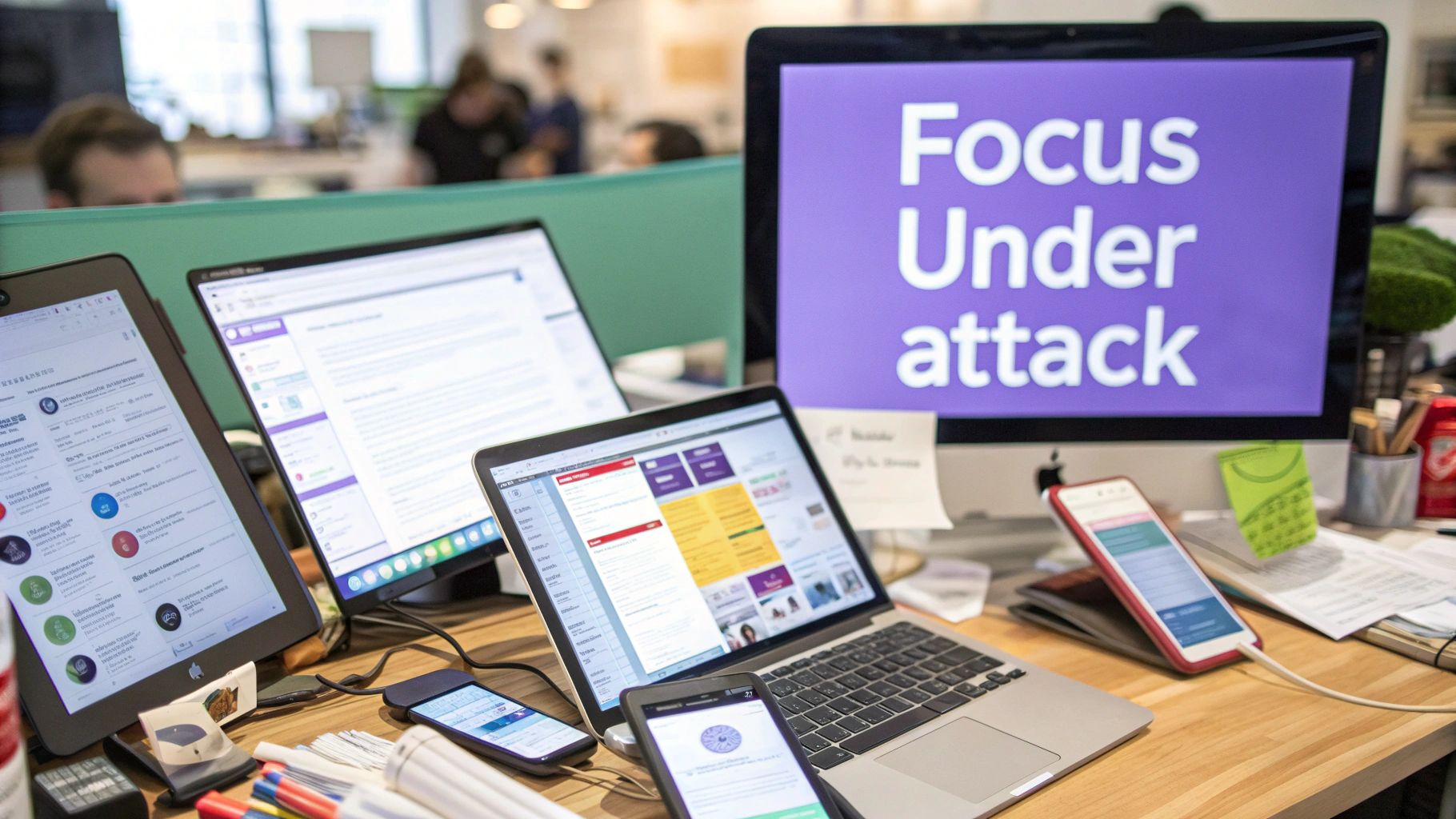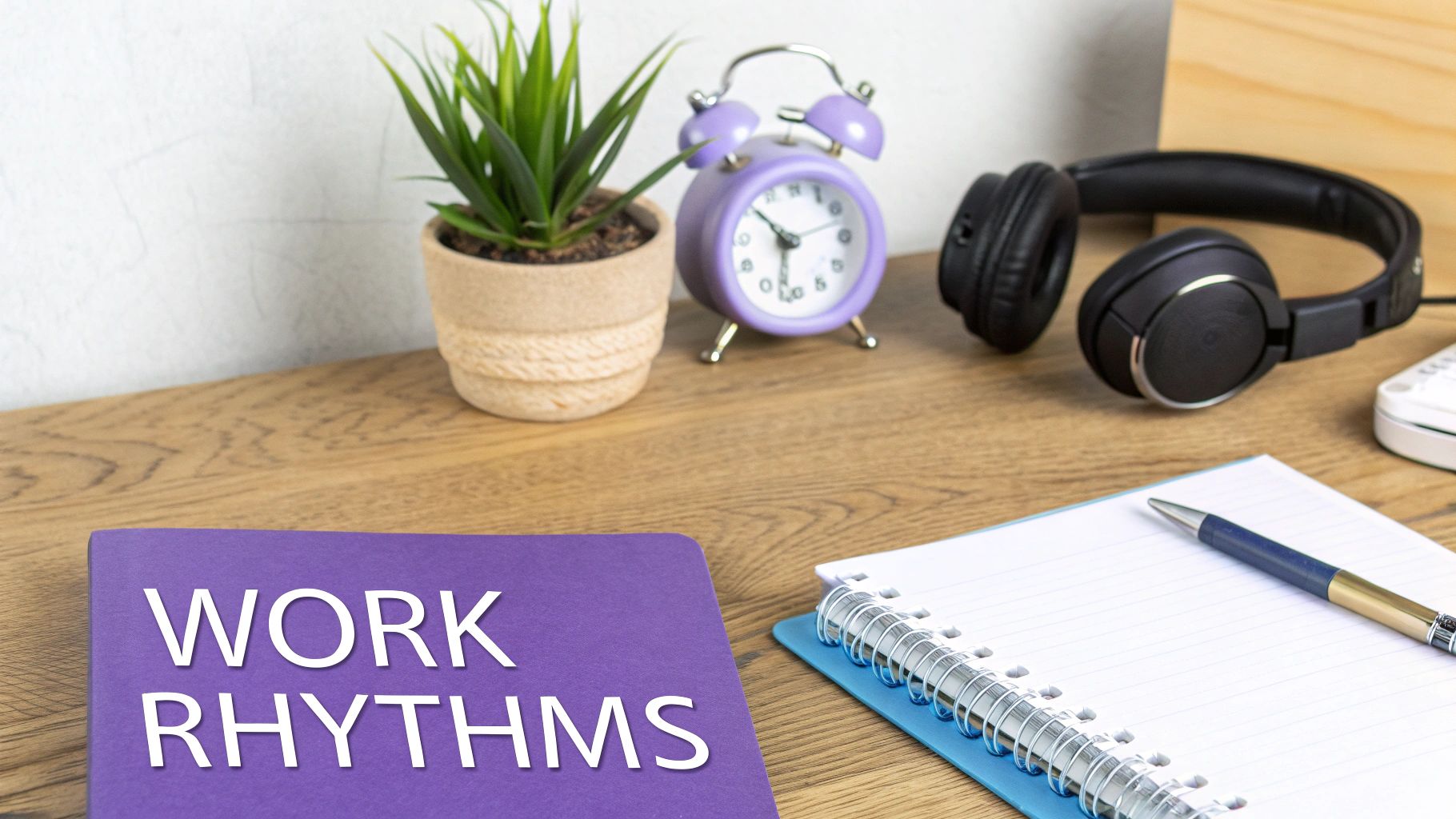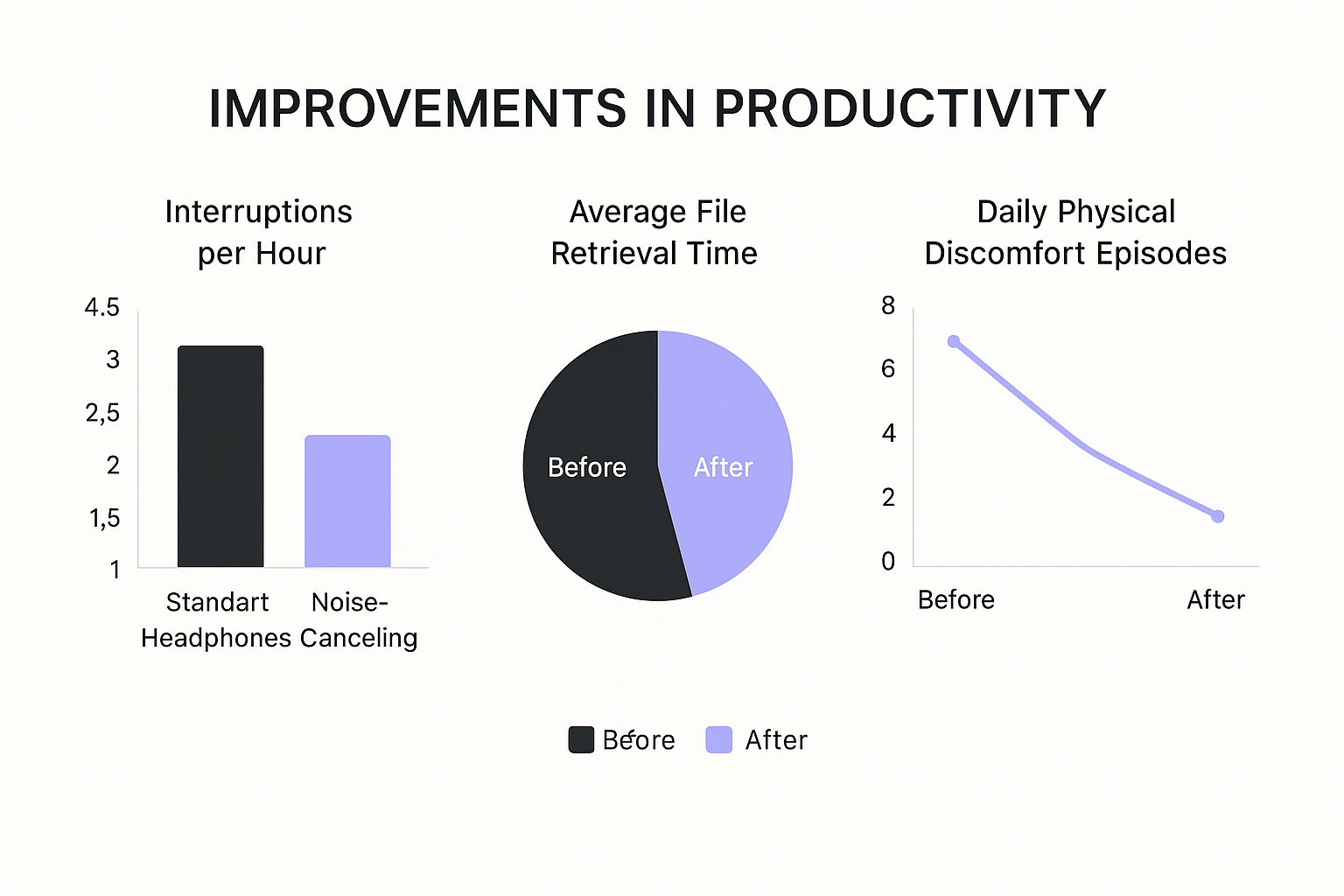How to Increase Focus at Work to Reclaim Your Day
Discover how to increase focus at work with proven strategies. Learn to master your time, design a distraction-free space, and build lasting focus habits.
Related reading
10 Proven Strategies to Boost Productivity in Desk Jobs [2024 Guide]
Discover game-changing strategies to boost your desk job productivity. Learn how smart breaks and innovative tools can transform your workday and skyrocket your efficiency.
If you feel like your brain is in a constant state of "too many tabs open" at work, you're not imagining things. The struggle to focus isn't a personal flaw; it's a direct result of how modern work is structured. To get back in the driver's seat, you need to be deliberate about shaping your environment and your schedule, building a defense against distractions instead of just trying to power through them.
Why Your Focus at Work Is Constantly Under Attack

Does this feel familiar? You’re deep into a project, making real progress, and then ping—a new email. Buzz—a Slack message. Another ping—a calendar reminder. Suddenly, your flow state is shattered.
This isn't a sign of weakness; it's by design. The modern office, whether physical or virtual, is a minefield of interruptions. We're wired for instant communication, which creates a culture of "continuous partial attention." We're always a little bit distracted, and that makes deep, meaningful work feel almost impossible.
The Real Cost of Distractions
Every time you get pulled away from what you're doing, it's not just a momentary blip. Research shows it takes an average of 23 minutes to get your focus back on track after an interruption. Think about how many times that happens in a single day.
This constant cycle of distraction and recovery is a huge drain. It leads directly to:
- Lost productivity as you waste precious time just trying to get back into the zone.
- Higher stress levels and a feeling of being mentally drained from all the context-switching.
- More mistakes because your attention is split in a dozen different directions.
This constant battle for your attention is exhausting and a fast track to feeling completely worn out. Our guide on https://www.deskbreak.app/blog/how-to-avoid-burnout-at-work explores this connection further and offers some solid advice for protecting your mental energy.
You can't just wish for more focus. You have to actively build a fortress around your attention, creating the space you need to do your best work.
For a really deep dive into the science behind concentration and more advanced techniques, check out this complete concentration playbook on how to focus at work. But for now, let's get into some practical, battle-tested solutions you can start using today.
Master Your Time with Strategic Work Cycles

Let’s be honest: those rigid, one-size-fits-all productivity hacks rarely work. Why? Because they completely ignore the natural ebb and flow of our energy throughout the day. To really sharpen your focus, you need a system that works with you, not against you.
The secret is ditching the idea of an eight-hour marathon and embracing what I call 'work sprints'—dedicated blocks of time for deep focus, punctuated by intentional rest. The real magic, though, is in the customization. Not every task is created equal, so why should your work sprints all be the same length?
Think of it this way: a project manager might need a solid 50-minute sprint to dive deep into strategic planning. But later that day, they can switch to shorter, 25-minute bursts to power through their inbox. This simple tweak helps you match your mental energy to the task's complexity, which is a game-changer for avoiding burnout. You can easily manage these intervals with a tool like a free online Pomodoro timer.
Redefining Your Breaks
What you do on your break matters just as much as the work itself. A real break isn't about swapping one screen for another. Mindlessly scrolling through your phone just trades one type of digital drain for another, leaving your brain just as fried.
An effective break is about giving your mind a genuine chance to wander and reset. The best way to do that is to get your body moving or simply shift your attention completely away from a screen. That's where you'll find real restoration for your focus and creativity.
These little resets, even if they're just for five minutes, are your best defense against the constant stream of workplace pings and shoulder taps.
And those interruptions are a bigger deal than you think. One study found that employees get interrupted roughly every 3 minutes, and it can take over 23 minutes to get back on track. If you want to dive deeper, you can find more 2025 workplace statistics on eptura.com. Taking strategic breaks helps build a mental buffer against this chaos.
So, what does a good break look like?
- Take a short walk: Just getting away from your desk and moving around does wonders for clearing your head.
- Try mindful breathing: A few minutes of deep breathing can instantly lower stress and reset your attention.
- Stretch it out: Sitting all day creates physical tension, which is a huge, often unnoticed, distraction.
When you start pairing these personalized work sprints with truly restorative breaks, you create a sustainable rhythm. It's how you protect your focus, sidestep burnout, and actually get more meaningful work done.
Engineer Your Workspace for Deep Focus
We often underestimate just how much our surroundings dictate our ability to concentrate. A messy desk, an uncomfortable chair, or a chaotic digital desktop are more than just minor annoyances; they're active barriers to focus, forcing your brain to work overtime just to tune them out. The real secret to increasing focus at work isn't about willpower—it's about making simple, smart changes to your physical and digital space.
The idea is to design an environment where focusing feels effortless, not like a struggle. This means getting rid of all the little points of friction that constantly pull your attention away from the task at hand.
Tidy Up Your Physical Environment
Your physical workspace is the bedrock of your productivity. If you're constantly fidgeting because of a nagging backache or neck strain, you're fighting a losing battle for focus. Poor ergonomics are a silent killer of concentration.
Start with the basics: adjust your chair height, monitor position, and keyboard placement to support a natural, comfortable posture. It makes a world of difference. For a deep dive, our guide on how to improve posture at your desk has some great, practical tips.
Noise is another huge focus-wrecker. Whether you're in a bustling open office or just have a noisy home, constant auditory interruptions make deep work feel impossible. A good pair of noise-canceling headphones is one of the best investments you can make. They create an instant "focus bubble" and send a clear signal to colleagues that you're in the zone.
Declutter Your Digital World
A messy digital space is just as distracting as a cluttered desk. Think about it: every minute you spend hunting for a file or sorting through a sea of browser tabs is a minute you're not working. That lost time shatters your momentum.
First, tackle your files. Create a simple, logical folder system and commit to using it. It might feel like a chore at first, but you'll thank yourself later when you can find any document in seconds.
Next, get a handle on browser tab chaos. I've found that using separate browser profiles—one strictly for work, another for personal stuff—is a game-changer. This simple divide keeps a quick work-related Google search from turning into a 30-minute scroll through social media.
Pro Tip: Stop letting notifications run your day. Instead of reacting to every single ping, try batch-checking your email and messages at set times, like 11 AM and 4 PM. This puts you back in the driver's seat.
Just look at the impact these kinds of environmental tweaks can have.

As you can see, these aren't minor improvements. By systematically removing physical discomfort and digital distractions, you build a solid foundation for the kind of deep, sustained focus that produces your best work.
Use Your Tech to Build Focus, Not Break It
It's easy to blame technology for our constant distractions, and let's be honest, it's often the main culprit. But what if we flipped that on its head? Instead of letting our devices dictate our attention spans, we can take control and make them work for us.
The secret is to stop being a passive consumer of notifications and start actively shaping your digital environment to protect your focus.
One of the smartest ways to do this is by automating the little, repetitive tasks that quietly eat away at your mental energy throughout the day. I'm talking about things like drafting the same kind of email over and over, summarizing dense documents, or trying to organize messy meeting notes. These tasks don't require your best thinking, but they still drain your cognitive battery.
Reclaim Your Cognitive Energy
This is where AI tools have become incredibly helpful for knowledge workers. By handing off these routine jobs to an AI assistant, you're not just saving time; you're preserving precious mental bandwidth for the work that actually matters.
The results speak for themselves. Companies that have integrated AI are seeing huge productivity boosts. In fact, a whopping 72% report high productivity, and almost 75% of knowledge workers feel that AI helps them save time and concentrate better. If you're curious about the data, you can dig into these employee productivity statistics on archieapp.co.
Beyond automation, you can also use tech to build a digital fortress around your attention. Purpose-built apps are fantastic for this:
- Website Blockers: These are a lifesaver. They stop you from unconsciously drifting over to social media or news sites when you should be in a deep work session.
- Focus Modes: Your phone and computer likely have a "focus mode" built right in. Use it. It silences all the non-critical pings and pop-ups, creating a quiet space for you to actually think.
- Task Managers: Getting your to-do list out of your head and into a digital system clears up so much mental clutter. It lets your brain focus on the task at hand instead of trying to juggle a mental list of everything else you need to do.
To help you find what works best for you, here’s a quick breakdown of some helpful tools and what they're good for.
Focus-Enhancing Tools and Their Best Use Cases
| Tool Category | Example Tools | Primary Benefit for Focus |
|---|---|---|
| Notification Management | Freedom, Built-in Focus Modes | Blocks distracting apps and websites, creating uninterrupted work blocks. |
| Task & Project Management | Asana, Trello | Organizes tasks visually, reducing mental clutter and decision fatigue. |
| Time Tracking & Pomodoro | Toggl Track, Forest | Structures work into focused sprints with built-in breaks to prevent burnout. |
| Note-Taking & AI Summary | Evernote, Archie | Captures ideas quickly and uses AI to summarize long docs, saving mental energy. |
Choosing the right combination of these tools can create a personalized system that defends against distractions and supports deep work.
By making deliberate choices about the technology you use and how you configure it, you can transform your devices from enemies of focus into your greatest allies. This proactive mindset is the key to staying sharp in a world that’s constantly trying to pull you in a million different directions.
Cultivate a Team Culture That Protects Deep Work

You can have the most dialed-in personal focus routine, but it won't stand a chance against a company culture that prizes constant availability. If your team treats every Slack notification like a fire alarm and your calendar looks like a game of Tetris, deep work is simply off the table.
Real, sustainable focus isn't just a solo mission—it's a team sport.
Building an environment that actually respects concentration takes deliberate effort from leadership and clear agreements across the team. This isn't just about being "nice"; it's about setting the stage for high-quality, creative work and keeping burnout at bay.
A great place to start is by setting clear boundaries around communication. For instance, you could create a rule that distinguishes urgent pings from everything else. Use Slack for quick, time-sensitive questions, but move longer, more complex conversations to email or a dedicated project management tool. This small shift prevents every little update from derailing someone's entire morning.
Establishing Focus-Friendly Norms
To make deep work a real part of your culture, your team needs to agree on some practical ground rules. Without shared guidelines, the one person trying to set boundaries can easily be seen as "not a team player," which is a fast track to resentment.
Here are a few norms I’ve seen work wonders:
- No-Meeting Blocks: Carve out a few hours each day as company-wide “focus time,” maybe from 9 to 11 AM. This gives everyone explicit permission to decline meetings and mute notifications without feeling guilty.
- Clear Status Indicators: Make it a habit for everyone to use Slack statuses like “Deep Work” or “Heads Down.” It’s a simple, visual cue that tells colleagues to hold off on non-urgent messages.
- Agenda-Only Meetings: Institute a policy that every meeting invitation must include a clear agenda and state the desired outcome. If an invite has no agenda, people should feel empowered to hit "decline."
When people trust that they can unplug to concentrate, their engagement and the quality of their work naturally go up. That trust is what builds a stable, focused, and high-performing team.
The data backs this up. Highly engaged teams see real business benefits that, in turn, protect everyone's focus. Research shows that teams in the top quartile for engagement have 78% less absenteeism and up to 51% less turnover. A consistent team is a productive team.
You can explore more insights about the link between empowerment and work on mckinsey.com.
Got Questions About Workplace Focus? Let's Troubleshoot.
Even when you've got a solid plan, real life has a way of throwing curveballs. The key isn't having a perfect system, but knowing how to handle the inevitable interruptions and distractions that pop up. Let's tackle a few common hurdles.
Is It Better To Do One Thing All Day, Or Switch Tasks?
This is a classic dilemma. While dedicating an entire day to one project sounds like the ultimate deep work fantasy, most of our jobs just don't work that way. We're constantly juggling.
The sweet spot for most people is task batching. Instead of jumping from an email to a spreadsheet to a phone call, group similar activities together. For instance, block out an hour just for answering emails or a 30-minute window solely for returning calls. This drastically cuts down on the mental "gear-shifting" that drains your energy.
What About "Urgent" Interruptions?
We've all been there. You're finally in the zone, and a coworker taps you on the shoulder with something "urgent."
The best strategy I've found is to have a polite but firm go-to phrase. Something as simple as, "I'm deep in a project right now, can I circle back with you in about an hour?" usually does the trick. It acknowledges their request without derailing your focus.
If it truly is a five-alarm fire, handle it. But afterward, be deliberate about getting back to what you were doing. Don't let the interruption win the rest of your afternoon.
What If I Just Can't Seem to Concentrate?
Some days, your brain just says "nope." You've minimized distractions, you've batched your tasks, but the focus just isn't there. This is a huge signal.
Nine times out of ten, it means you're mentally tapped out or physically fatigued. Pushing through is almost always the wrong move. Instead of fighting it, take a real break. A quick walk outside, a few minutes of stretching, or even just staring out the window can do more for your productivity than another hour of staring at a blinking cursor.
Learning to listen to your body and mind is a skill. For a deeper dive into building these foundational habits, this is an excellent guide on how to improve focus and concentration. Responding to mental fog with rest, not more force, is what creates sustainable focus for the long haul.
Ready to build a healthier, more focused work routine? DeskBreak is the browser extension that reminds you to stretch, hydrate, and rest your eyes, turning guilt-free breaks into your secret weapon for productivity. Get DeskBreak today and reclaim your focus.